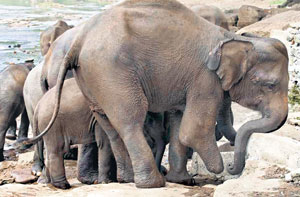
Treading on man’s hidden warApril 4 was the International Day for Mine Awareness and Assistance in Mine Action. Every year hundreds of innocent civilians lose their limbs accidentally stepping on mines. Here Malaka Rodrigo looks at the plight of the elephants, the forgotten victims of landmines. Pic by Gemunu Amarasinghe In the battle between Dutugemunu and Elara, both kings rode on elephants - Gemunu mounted on Kandula and Elara on Maha Pabbatha. Both elephants were injured fighting their kings’ war. The outcome of the battle is history, but even though centuries have passed, elephants are still sacrificed in the cruel wars waged by man. Today, in Sri Lanka, wild elephants face a terrible death if they accidentally step on mines in the Northern and Eastern theatres of war.
Sama, the three-legged landmine survivor now at the Pinnawela Elephant Orphanage is a living symbol of the cruelty of land mines. She was a little elephant at the time she was rescued in 1991, abandoned in an Eastern jungle by the herd. Part of her right fore-leg below the knee had been lost as a result of a landmine. While Sama’s friends frolic in the river, she watches wistfully, unable to join them. A German team’s efforts to give Sama an artificial leg a few years ago failed when Sama refused to accept it, banging it onto a wall and destroying it. Pinnawela authorities have now given up the idea of further attempts and Sama is still hopping about on three legs as she grows. Even now Sama’s spine is curved due to the uneven force created by hopping and bending. “This will shorten Sama’s life,” a Pinnawala vet said. In the Eastern battlefields, at least 20 elephants have fallen victims to landmines. During the past few years, most of the victims were reported from Toppigala and Vakarai. The latest victim was reported few days ago in Toppigala near Meeyankolla aru. The elephant’s right hind-leg had been injured and it can hardly walk. The soldiers of the 232 Brigade who found the jumbo are now keeping an eye on it till the veterinary team gets there. Once the cushion of the elephant’s foot is damaged, recovery is unlikely but the worst is when an elephant loses its trunk. At Andamkulam, a hapless jumbo lost part of its trunk while sniffing a landmine. Without its trunk, the animal had to nibble its food with great difficulty. At least three cases of elephants having their trunks damaged due to mines have been reported. Wild boar and cattle are the other frequent victims, but they are usually killed instantly. Treating the elephants is a dangerous business. Usually the elephants are found in the unsecured areas where there may be more landmines. In addition to the threat posed by mines, the veterinary surgeons of the armed forces also face the threat of rebel attacks. The elephant usually goes to a water hole to put its injured leg in the mud. These open areas are virtually traps for terrorists to open fire. A veterinary surgeon recalled travelling in a Unicorn armored vehicle used by the army to cross a suspected unsecured stretch to reach an injured elephant. The team had to go on foot to reach the elephant that had taken refuge in a large water hole. The dedication of these veterinary surgeons needs to be praised. They have minimum facilities, but they treat the life of the animal as their first priority. The support extended by the armed forces is also commendable. “But we can do very little to save the elephants if its foot is badly damaged. Usually the elephant faces a painful death,” an officer who was part of the team that treated a land mine victim said sadly. Unearthing the mines Sri Lanka set up a National Steering Committee on Mine Action in 2002. Since the Peace Accord, several INGOs, local institutes and the armed forces have continued to remove mines in some 730 identified villages. According to the chairman of the committee, 60% of the identified area has been cleared so far. “90% of the identified areas in the Eastern Province are clear now. Our aim is to clear all the mines in these areas before June,” said chairman M.S. Jayasinghe. The UNDP’s Mine Action office says there has been a steady decrease in the number of deaths from incidents involving landmines (an explosive remnant of war). This is despite the sharp increase in 2006 when fighting broke out again. The number of landmine casualties last year stood at 17 down from 64 in 2006. Sometimes dogs are used to sniff out landmines in villages. The mines are then taken out to a clear area for diffusing. Bush cutters and Flail machines are used to explode mines in the open areas. However, mines in the peripheral jungle areas may go unnoticed. |
|
||||||
|| Front
Page | News | Editorial | Columns | Sports | Plus | Financial
Times | International | Mirror | TV
Times | Funday
Times || |
| |
Reproduction of articles permitted when used without any alterations to contents and a link to the source page.
|
© Copyright
2008 | Wijeya
Newspapers Ltd.Colombo. Sri Lanka. All Rights Reserved. |
